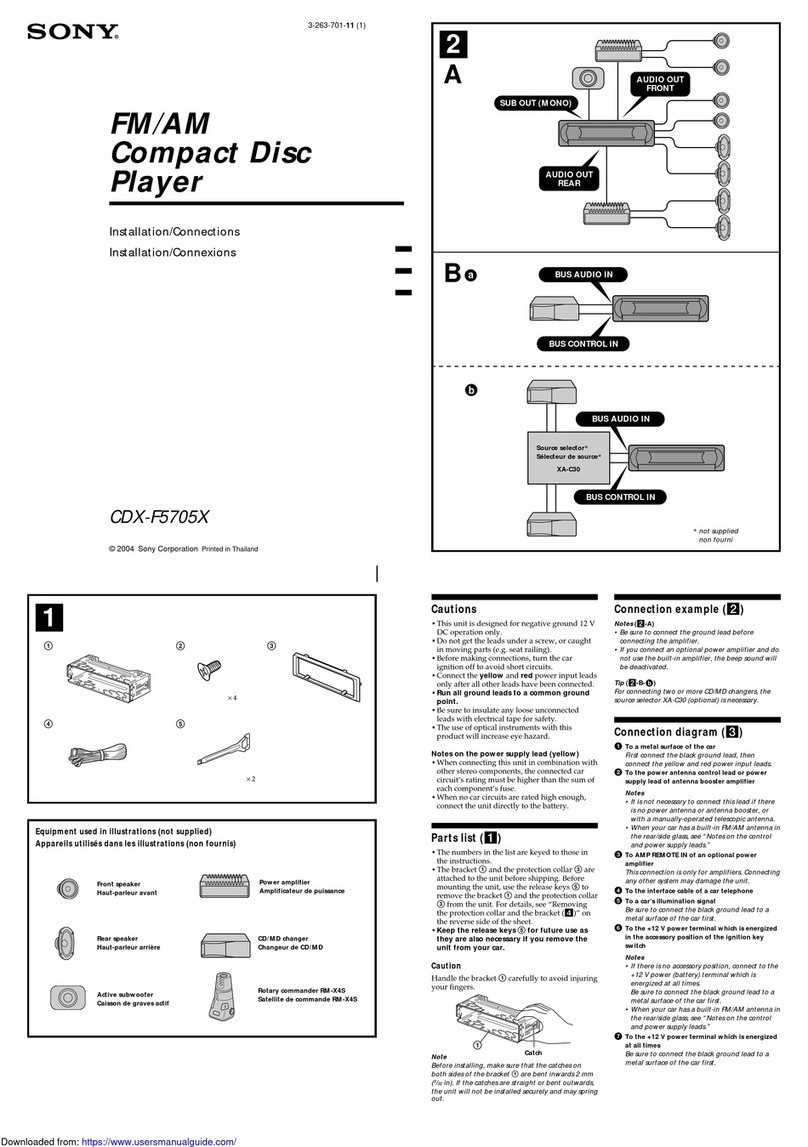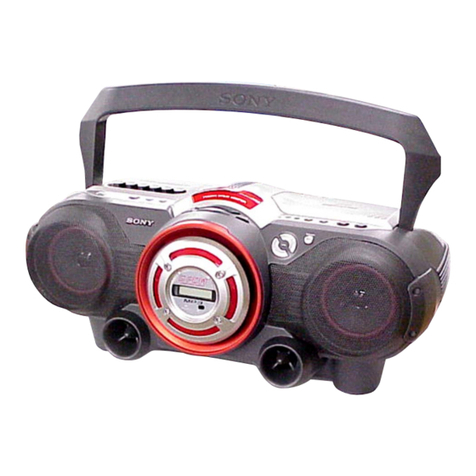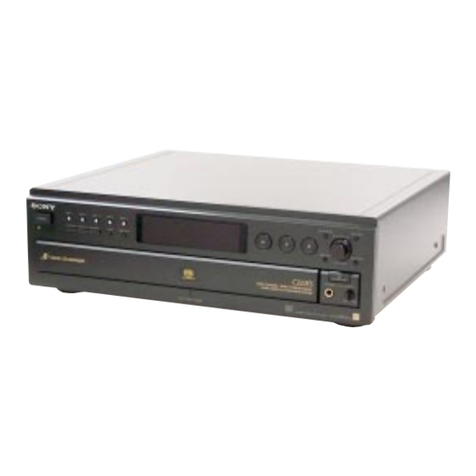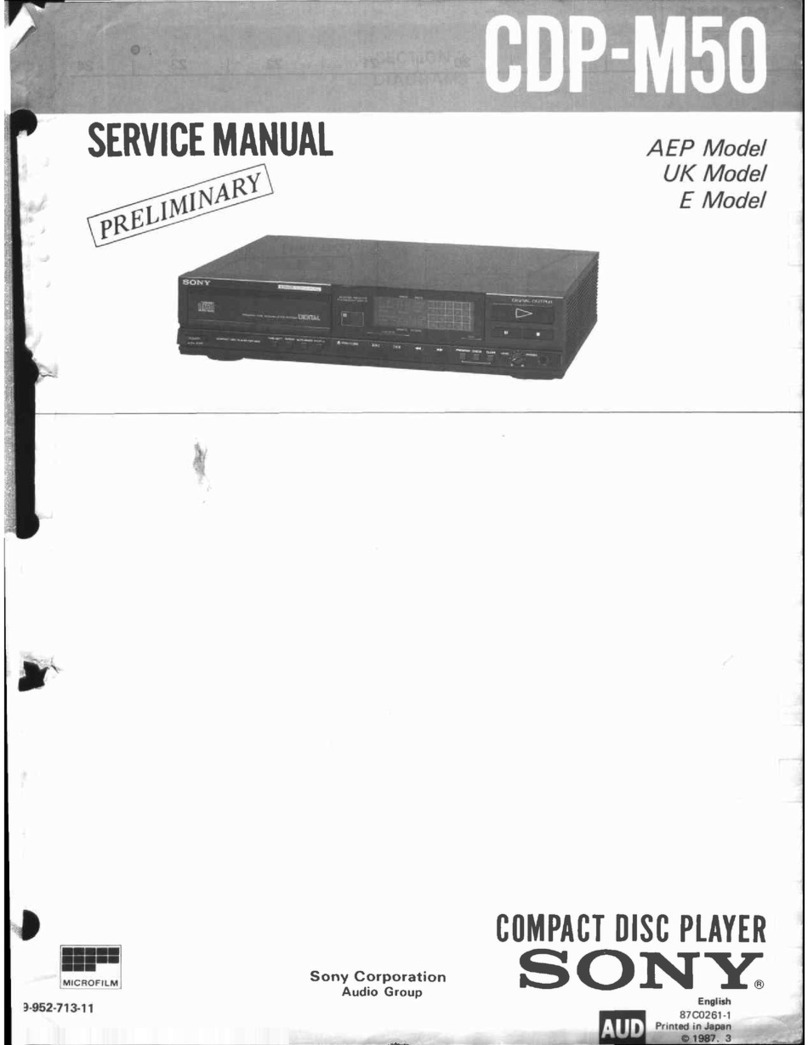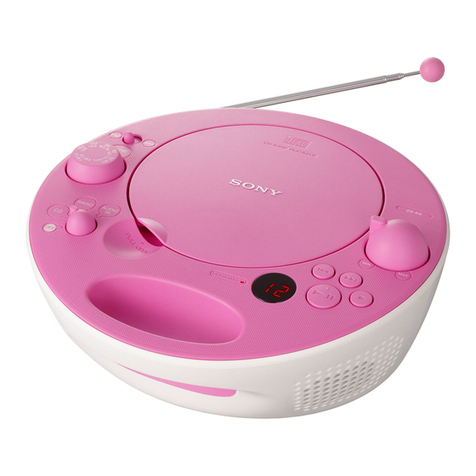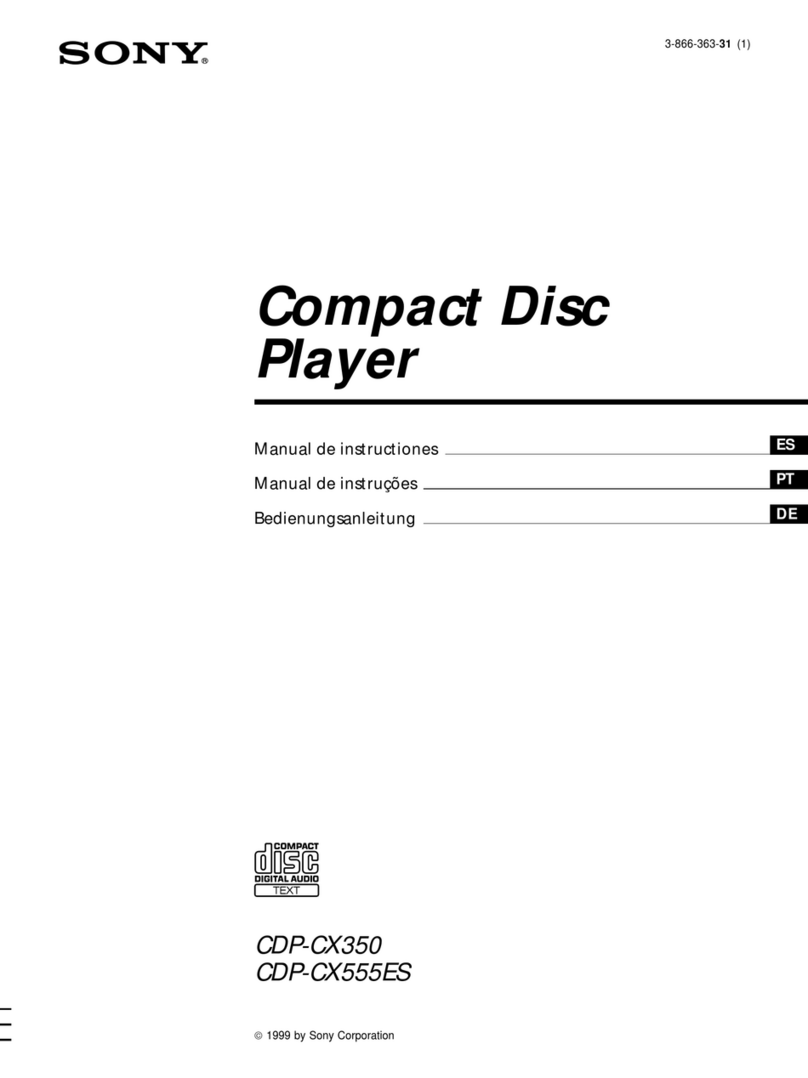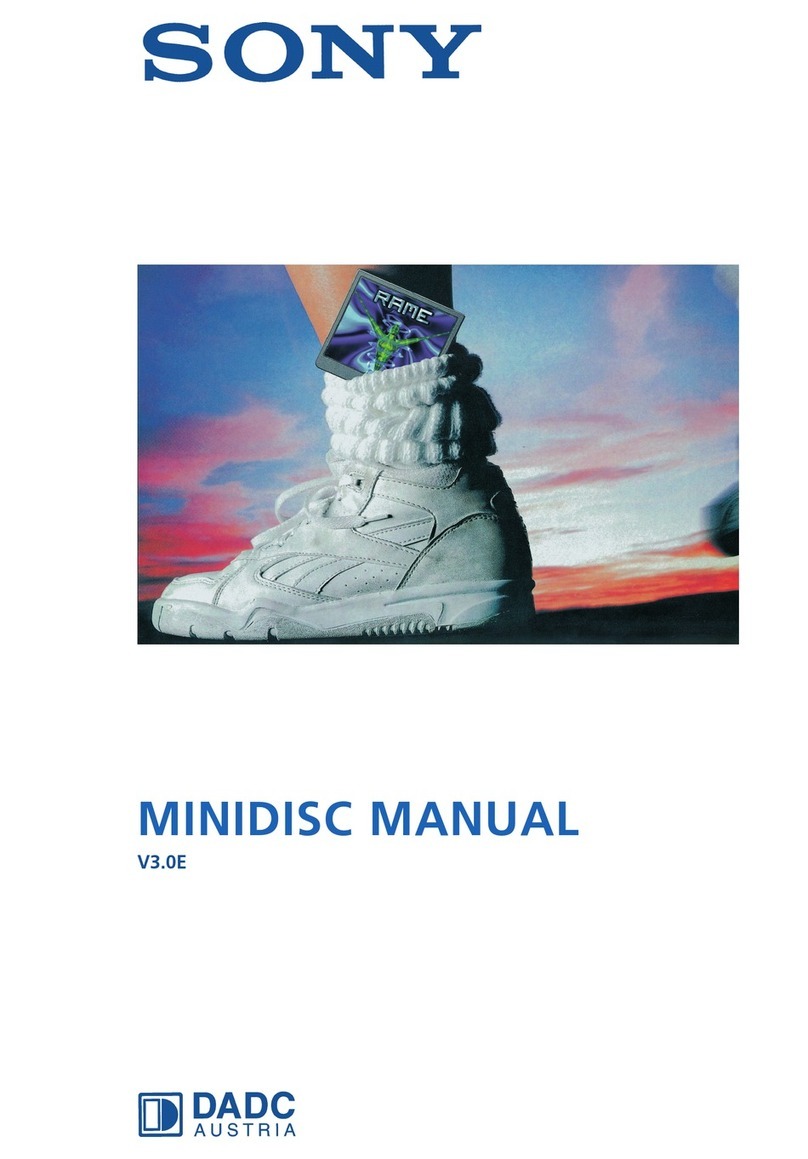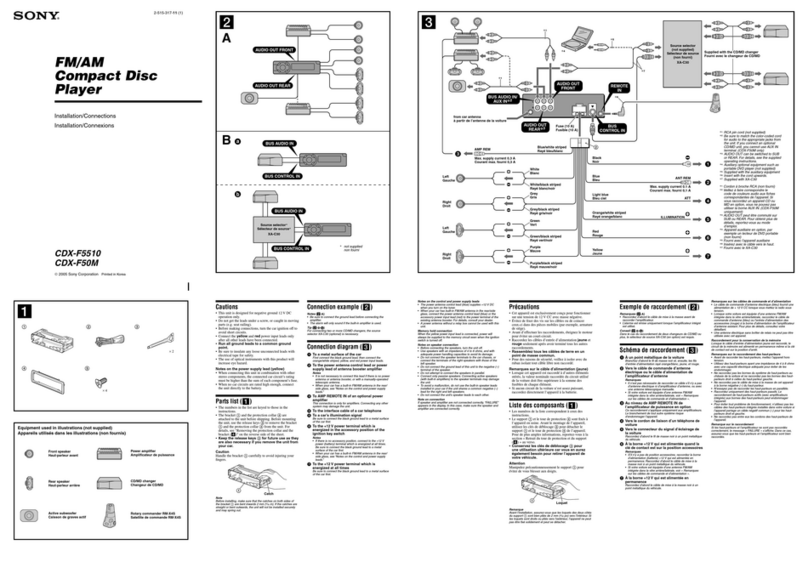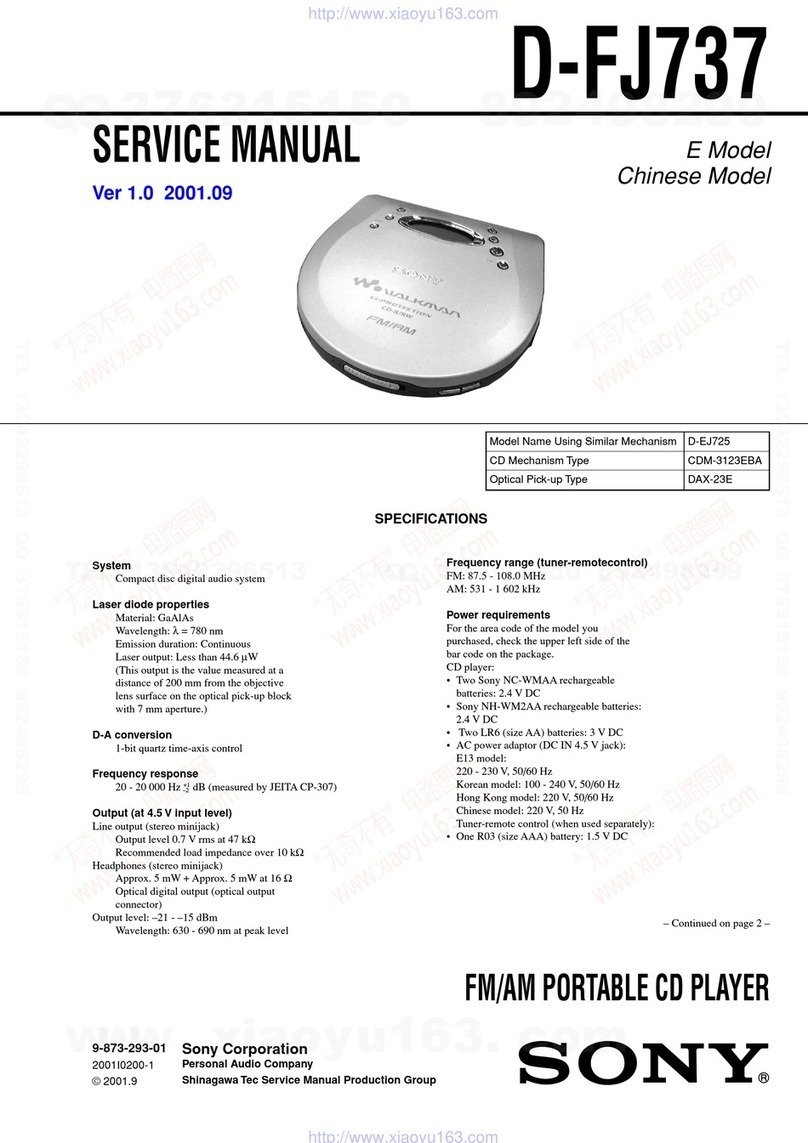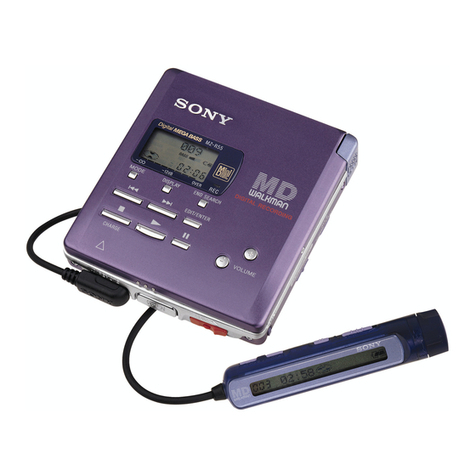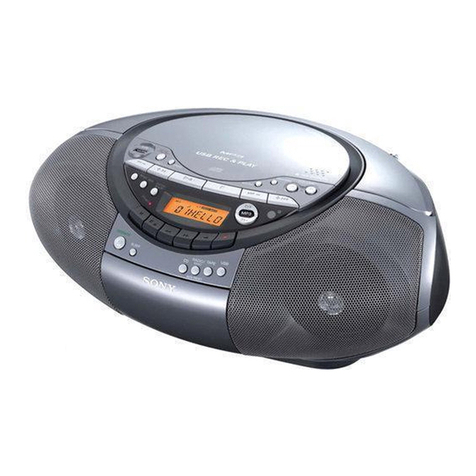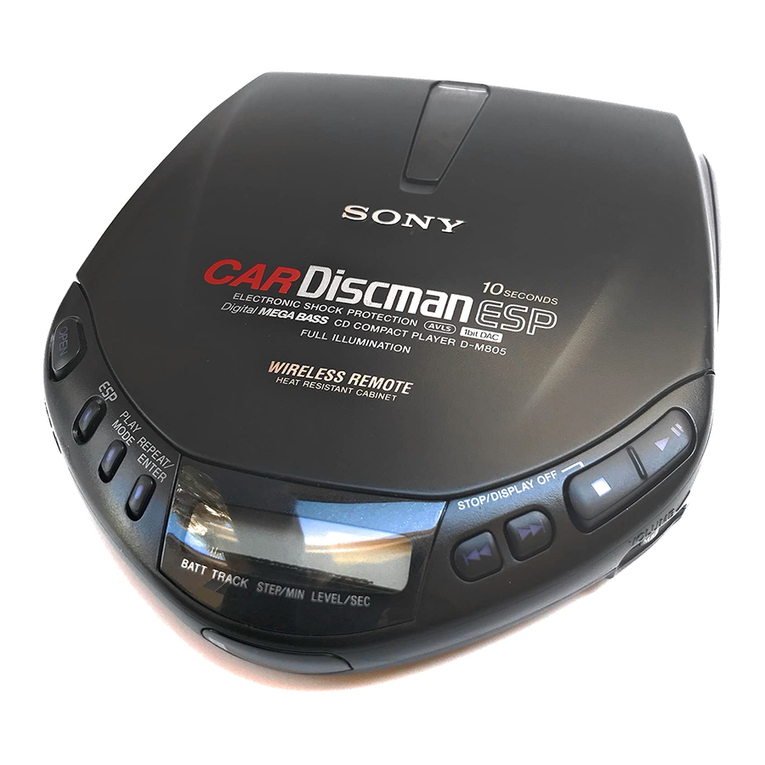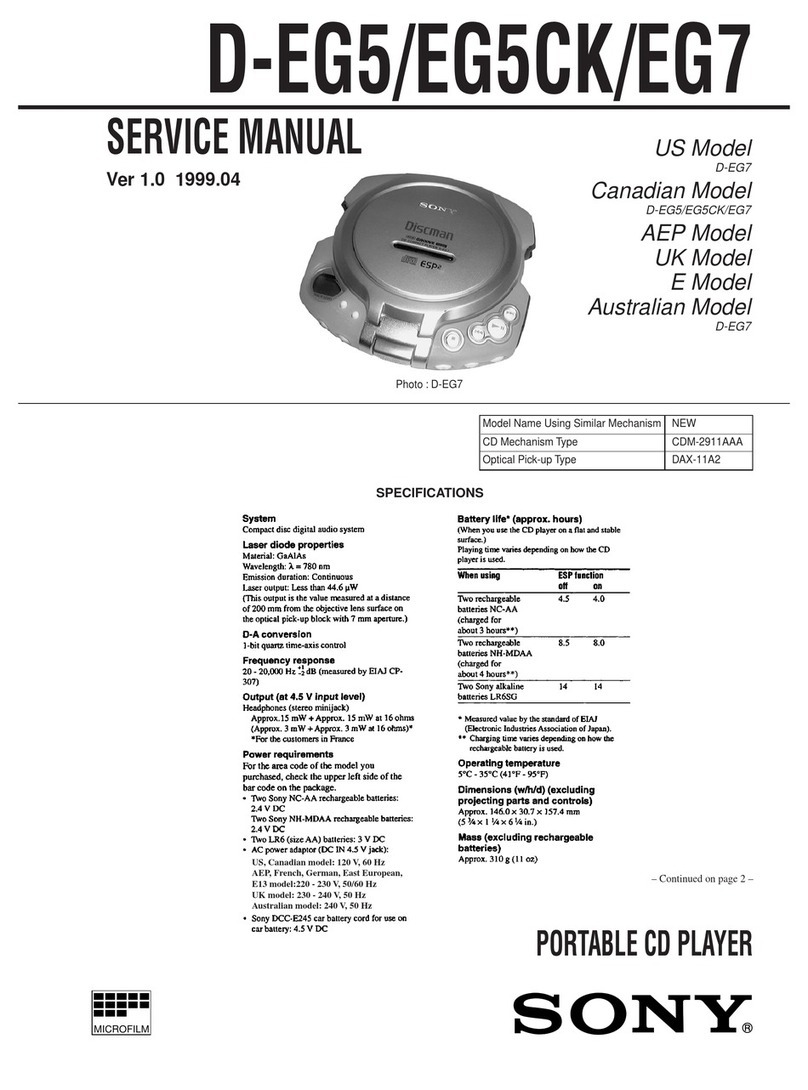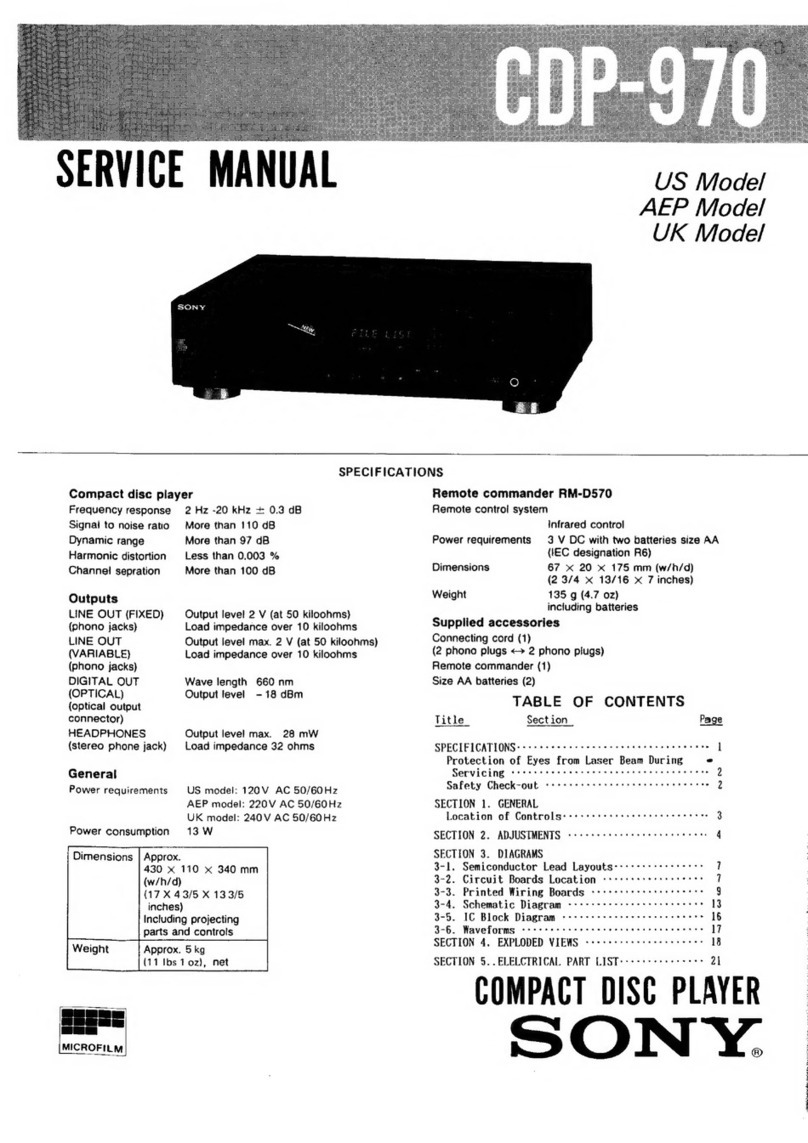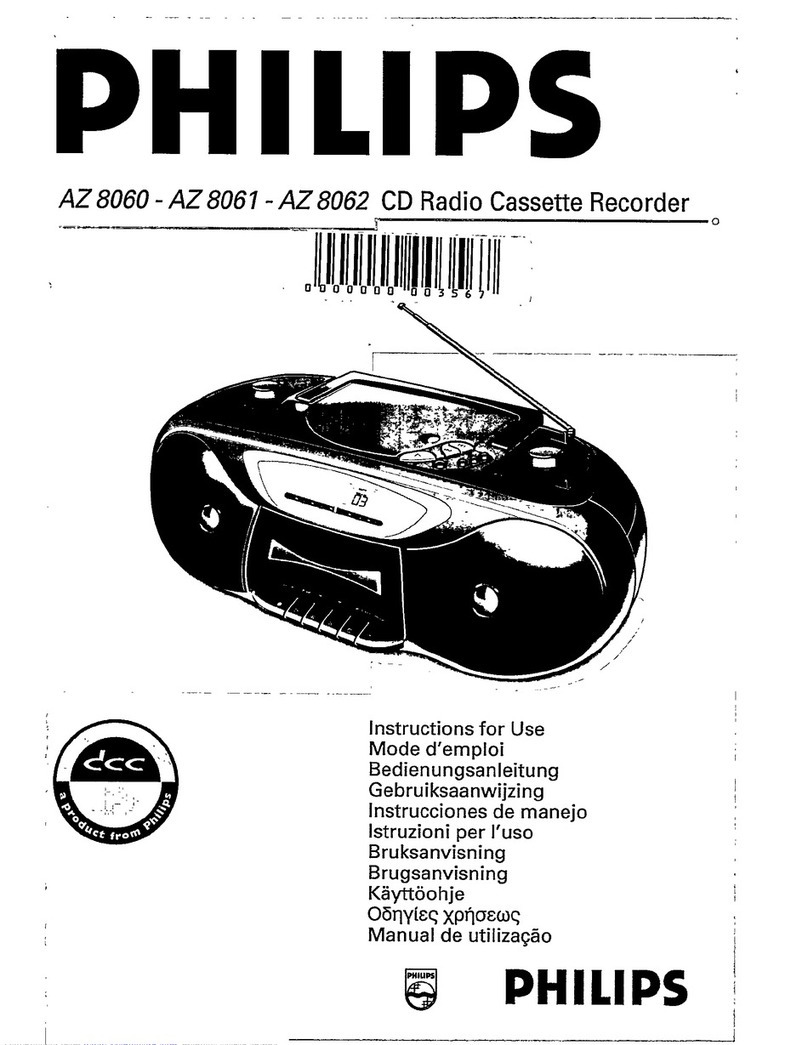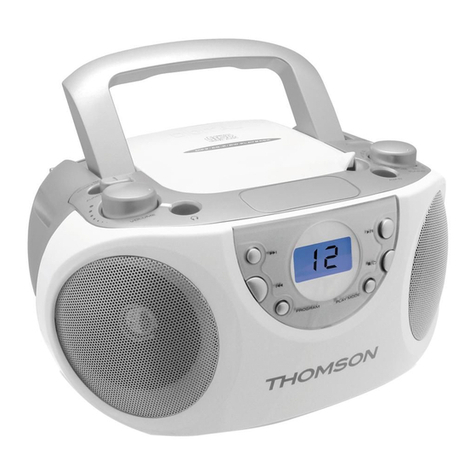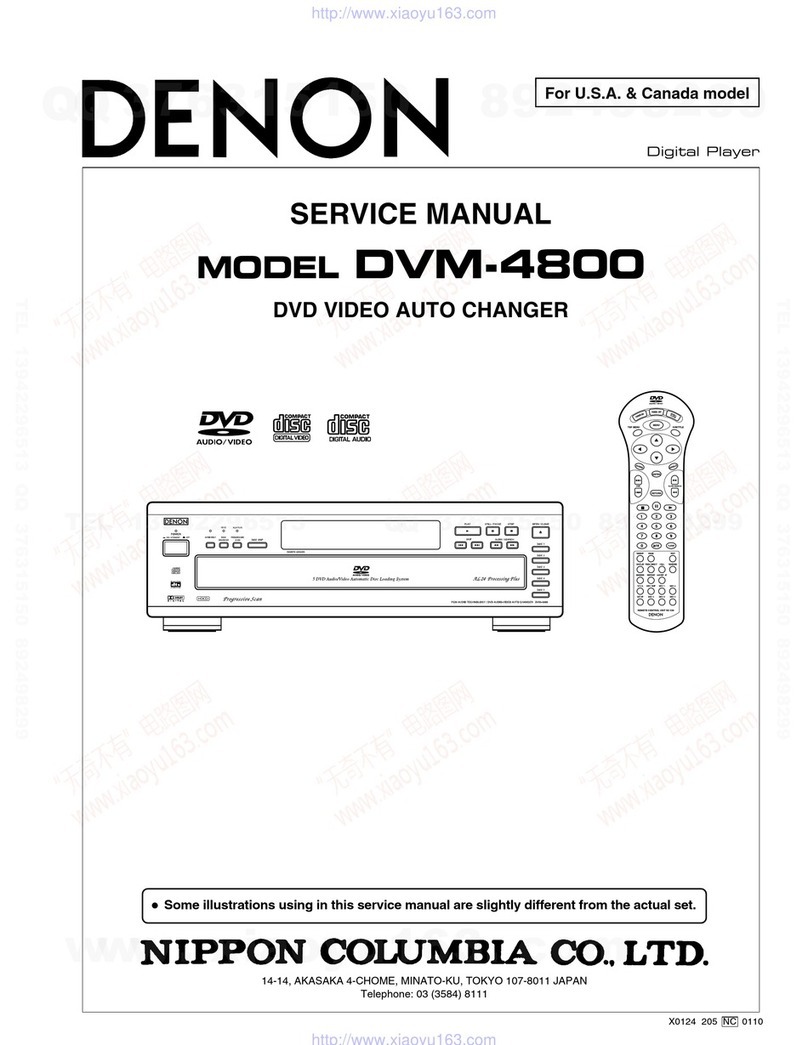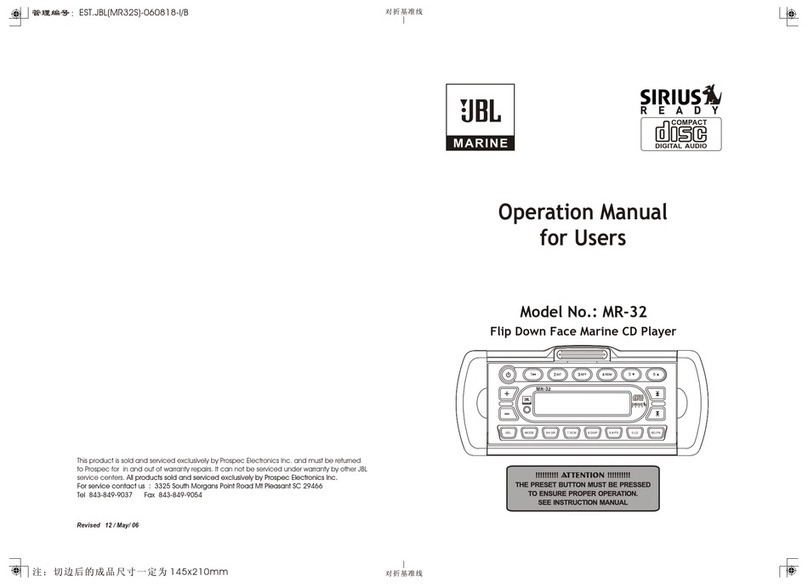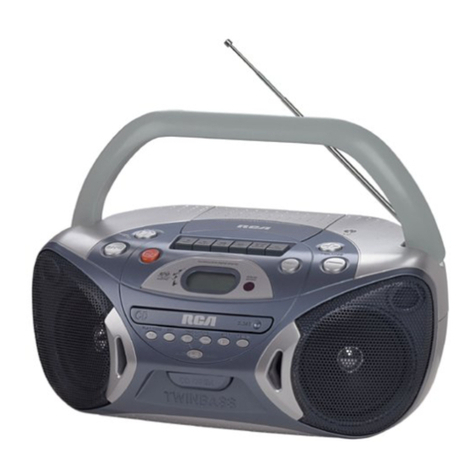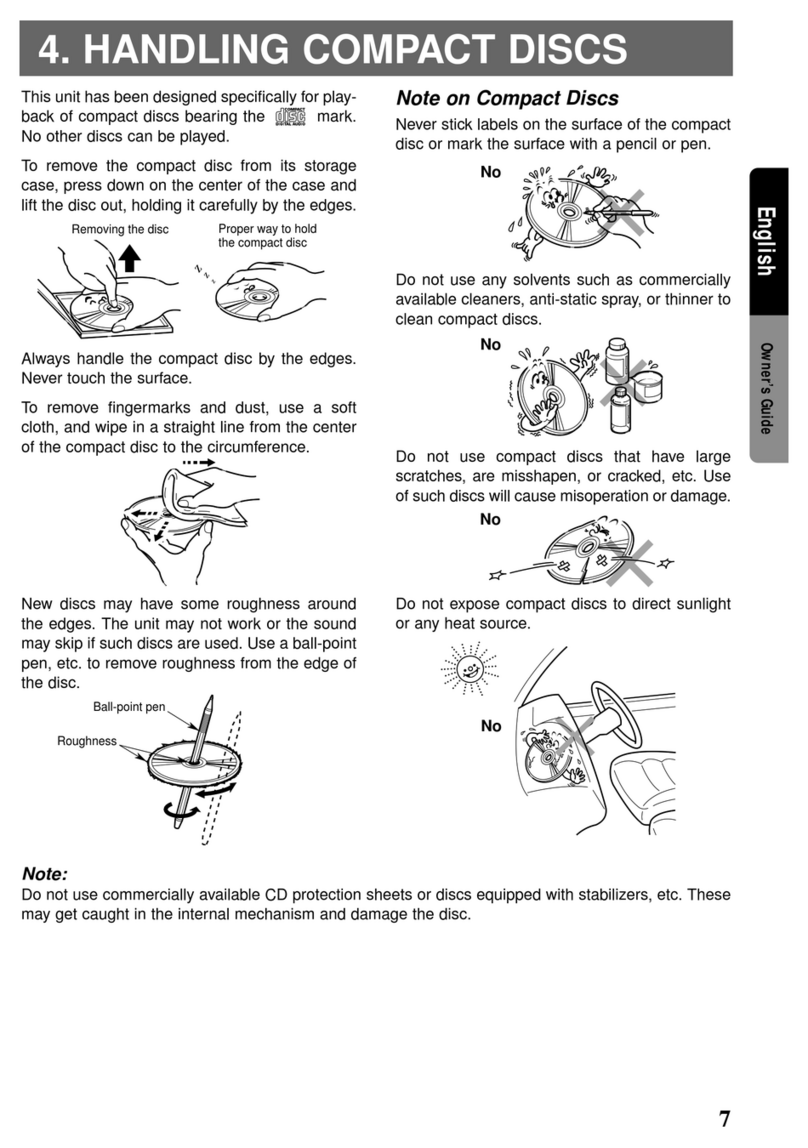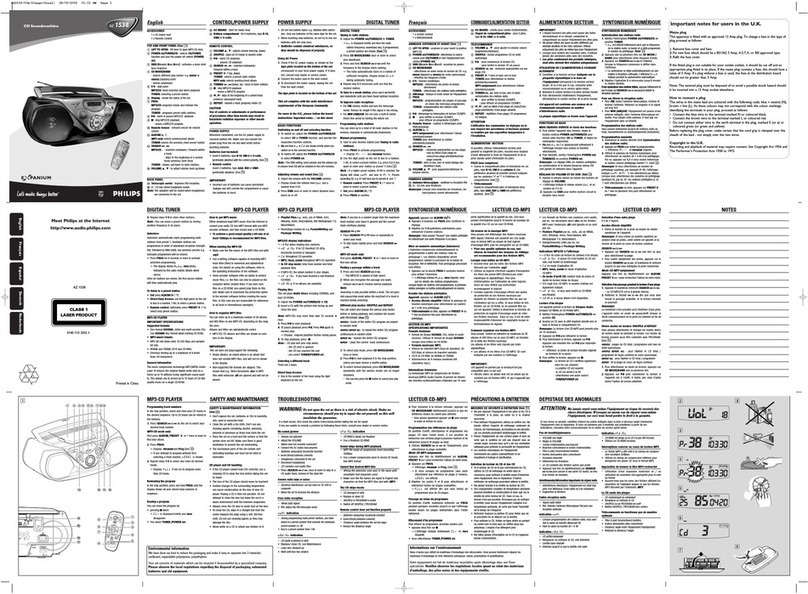
Playing a CD in a car
You can use your player in a car as illustrated
below.
To connect your CD player to a car cassette
deck, you need the following accessories:
•Car connecting pack
•Car battery cord
You cannot use the car mount plate for this
CD player.
Refer to the instruction manual of each
accessory for details.
Notes
• Do not put the CD player on the dashboard.
• Do not leave the CD player in a car parked
under sunlight.
• If the sound is distorted, press SOUND until
the BASS indication disappears from the
display.
• Use a Sony car connecting pack for reducing
noise.
• Use only the car battery cord listed in the
optional accessories. If you use any other car
battery cord, smoke, fire or malfunction may
occur.
Switched ignition function
(when using the car battery cord)
With this feature, your CD player stops
automatically when you turn off the engine of
the car. (This function is not possible with
some cars depending on the model.)
Using the supplied remote
control
You can use the remote control as the wired
remote control.
* Automatic Music Sensor
**When you are not using the remote control,
slide HOLD in the direction of the arrow to
prevent any accidental operations.
To unlock, slide HOLD back.
BPower Sources
Using the rechargeable
batteries
Charge the rechargeable batteries before
using them for the first time. You can use
only the following rechargeable batteries for
your CD player.
•NC-WMAA
•NH-WM2AA
1Open the battery compartment lid.
2Insert two rechargeable batteries by
matching the 3to the diagram in the
battery compartment and close the lid.
3Connect the AC power adaptor to the DC
IN 4.5 V jack of your CD player and an
AC outlet, then press x/CHG to start
charging.
The CD player charges the batteries. The
“CHG” indicator turns on in the display,
and the indicator sections of light
up in succession. When the batteries are
completely charged, the “CHG” and
indicators turn off.
If you press x/CHG after the charge has
already been completed, the
indicator flashes and “Full” appears in
the display.
4Disconnect the AC power adaptor.
To remove the rechargeable
batteries
Remove the batteries as illustrated below.
BAdditional Information
Precautions
On safety
• Should any solid objects or liquid fall into the
unit, unplug it and have it checked by
qualified personnel before operating it any
further.
• Do not put any foreign objects in the DC IN
4.5 V (external power input) jack.
On power sources
• When you are not using the CD player for a
long time, disconnect all power sources from
the player.
On the AC power adaptor
• Use only the supplied AC power adaptor. If
your player is not supplied with it, use AC-
E45HG AC power adaptor. Do not use any
other AC power adaptor.
• To unplug the AC power adaptor from the
wall outlet, grasp the adaptor itself, do not pull
its cord.
On rechargeable batteries and dry
batteries
• Do not charge the dry batteries.
• Do not throw the batteries into fire.
• Do not carry the batteries with coins or other
metallic objects. It can generate heat if the
positive and negative terminals of the battery
are accidentally contacted by a metallic object.
• Do not mix rechargeable batteries with dry
batteries.
• Do not mix new batteries with old ones.
• Do not use different types of batteries together.
• When the batteries are not to be used for a long
time, remove them.
• If battery leakage occurs, wipe off any deposit
in the battery compartment, and install new
batteries. In case the deposit adheres to you,
wash it off thoroughly.
On the CD player
• Keep the lens of the CD player clean and do
not touch it. If you do so, the lens may be
damaged and the player will not operate
properly.
• Do not put any heavy object on top of the
player. The unit and the CD may be damaged.
• Do not leave the CD player in a location near
heat sources, or in a place subject to direct
sunlight, excessive dust or sand, moisture,
rain, mechanical shock, unleveled surface, or
in a car with its windows closed.
• If the CD player causes interference to radio or
television reception, turn off the CD player or
move it away from the radio or television.
• Do not wrap the CD player in a cloth or
blanket during use as it may cause malfunction
or serious accidents.
• Discs with non-standard shapes (e.g., heart,
square, star) cannot be played on this CD
player. Attempting to do so may damage the
CD player. Do not use such discs.
On headphones/earphones
Road safety
Do not use headphones/earphones while
driving, cycling, or operating any motorized
vehicle. It may create a traffic hazard and is
illegal in some areas. It can also be potentially
dangerous to play your headsets at high volume
while walking, especially at pedestrian
crossings. You should exercise extreme caution
or discontinue use in potentially hazardous
situations.
Preventing hearing damage
Avoid using headphones/earphones at high
volume. Hearing experts advise against
continuous, loud and extended play. If you
experience a ringing in your ears, reduce volume
or discontinue use.
Caring for others
Keep the volume at a moderate level. This will
allow you to hear outside sounds and to be
considerate to the people around you.
Maintenance
To clean the casing
Use a soft cloth slightly moistened in water or a
mild detergent solution. Do not use alcohol,
benzine or thinner.
Troubleshooting
Should any problem persist after you have made
these checks, consult your nearest Sony dealer.
The CD does not play or “no dlSC”
appears in the display though a CD
is placed in the unit.
cThe CD is dirty or defective.
cInsert the CD with the label side up.
cMoisture condensation has occurred.
Leave the unit aside for several hours until
the moisture evaporates.
cClose the lid of the unit and the battery
compartment firmly.
cMake sure the batteries are inserted
correctly.
cConnect the AC power adaptor to a wall
outlet securely.
cThe CD-R was not finalized. Finalize the
CD-R with the recording device.
cThere is a problem with the quality of the
CD-R, recording device, or application
software.
When you press >N, “00”
appears in the display for a
moment, and disappears. The CD
does not play.
cRechargeable batteries are used up
completely. Charge the batteries.
cReplace the batteries with new LR6 (size
AA) alkaline batteries.
No sound, or noise is heard.
cConnect the plugs firmly.
cPlugs are dirty. Clean the plugs with a dry
soft cloth periodically.
“Hl dc ln” appears in the display.
cUse only the supplied AC power adaptor
or AC power adaptor AC-E45HG (not
supplied).
“Hold” appears in the display when
you press a button.
cThe buttons are locked. Slide HOLD back.
The indication appears in the
display when you press a button.
cRechargeable batteries are used up
completely. Charge the batteries.
cReplace the batteries with new LR6 (size
AA) alkaline batteries.
The battery life is short.
cManganese batteries are used. Use alkaline
batteries.
cReplace the batteries with new ones.
The volume is limited to a certain
level even if you attempt to turn it
up.
cAVLS function keeps down the volume.
Hold down SOUND until “AVLS”
disappears from the display.
Playback starts from the point you
stopped.
cThe resume function is working. Open the
lid of the CD player; or remove all power
sources, then insert the batteries or
connect the AC power adaptor again.
Specifications
CD player
System
Compact disc digital audio system
Laser diode properties
Material: GaAlAs
Wavelength: λ = 780 nm
Emission duration: Continuous
Laser output: Less than 44.6 µW (This output
is the value measured at a distance of 200
mm from the objective lens surface on the
optical pick-up block with 7 mm aperture. )
Error correction
Sony Super Strategy Cross Interleave Reed
Solomon Code
D-A conversion
1-bit quartz time-axis control
Frequency response
20 - 20 000 Hz +1
–3 dB (measured by EIAJ CP-
307)
Output (at 4.5 V input level)
Headphones (stereo minijack)
Approx. 12 mW + approx. 12 mW
at 16 Ω
General
Power requirements
For the area code of the model you purchased,
check the upper left side of the bar code on the
package.
• Two Sony NC-WMAA rechargeable
batteries: 2.4 V DC
• Sony NH-WM2AA rechargeable batteries:
2.4 V DC
• Two LR6 (size AA) batteries: 3 V DC
• AC power adaptor (DC IN 4.5 V jack):
U/U2/CA2/E92/MX2/TW2/BR3 model:
120 V, 60 Hz
CED/CEX/CET/CEW/CE7/EE/EE1/
E13/G5/G6/G7/G8/BR1 model:
220 - 230 V, 50/60 Hz
CEK/3CE7 model: 230 - 240 V, 50 Hz
AU2 model: 240 V, 50 Hz
JE.W/E33/EA3 model: 100 - 240 V,
50/60 Hz
HK2 model: 220 V, 50/60 Hz
AR1/CNA model: 220 V, 50 Hz
Dimensions (w/h/d) (without projecting parts
and controls)
Approx. 130.0 ×26.3 ×150.5 mm
(5 1⁄8 ×1 1⁄16 ×6 in.)
Mass (excluding accessories)
Approx. 205 g (7.3 oz)
Operating temperature
5°C - 35°C (41°F - 95°F)
Supplied accessories
For the area code of the model you purchased,
check the upper left side of the bar code on the
package.
AC power adaptor (1)
Headphones with remote control (1)
Rechargeable batteries (2)
Battery carrying case (1)
Design and specifications are subject to change
without notice.
For US customers
AC power adaptor supplied is not intended to be
serviced. Should the AC power adaptor cease to
function in its intended manner, during the
warranty period, the adaptor should be returned
to your nearest Sony Service Center or Sony
Authorized Repair Center for replacement, or
after warranty period, it should be discarded.
Stereo miniplug Micro plug
Polarity of the plug
r
○○○○ ○○○○
r
r
r
r
When to charge the rechargeable
batteries
You can check the remaining power of the
batteries in the display.
Battery power is full.
Battery power is getting low.
Battery power is low.
Lo batt* Batteries are depleted.
*Beep sounds.
To keep the original battery capacity for a
long time, charge the batteries only when
they are completely depleted.
Notes
• The indicator sections of roughly shows
the remaining battery power. One section does
not always indicate one-fourth of the battery
power.
• Depending on operating conditions, the
indicator sections of may increase or
decrease.
When to replace the rechargeable
batteries
If the battery life becomes shorter by about
half, replace the batteries with new
rechargeable batteries.
Note on the rechargeable batteries
If the battery is new or has not been used for
a long time, it may not be charged completely
until you charge and discharge it several
times.
Note on carrying the rechargeable
batteries
Use the supplied battery carrying case to
prevent unexpected heat. If the rechargeable
batteries and the metallic objects are
contacted, heat or fire may occur due to a
short circuit.
To attach the battery compartment
lid
If the battery compartment lid is detached by
an accidental drop, excessive force, etc.,
attach it as illustrated below.
r
○○○○ ○○○○
r
r
r
r
Using the dry batteries
Use only the following dry battery type for
your CD player:
•LR6 (size AA) alkaline batteries
Note
Be sure to remove the AC power adaptor when
using the dry batteries.
1Open the lid of the battery compartment.
2Insert two LR6 (size AA) alkaline
batteries by matching the 3 to the
diagram in the battery compartment.
To remove the batteries
Remove the batteries in the same way as
rechargeable batteries.
When to replace the batteries
You can check the remaining power of the
batteries in the display.
Battery power is full.
Battery power is getting low.
Battery power is low.
Lo batt* Batteries are depleted.
*Beep sounds.
When the batteries are depleted, replace both
batteries with new ones.
Battery life (approx. hours)(EIAJ*)
Battery life varies depending on how the
player is used.
ESP OFF ESP ON
Two NC-WMAA 8 8
(charged for
about 3 hours**)
NH-WM2AA 14.5 14
(charged for
about 8 hours**)
Two Sony alkaline 25 24
batteries LR6(SG)
* Measured value by the standard of EIAJ
(Electronic Industries Association of Japan).
(When the unit is used on a flat and stable
place.)
** Charging time varies depending on how the
rechargeable battery is used.
(rear)
x/CHG button
to an AC outlet
DC IN 4.5 V
AC power adaptor
Optional accessories
Car connecting pack CPA-9C
Car battery cord with car connecting pack
DCC-E34CP
Car battery cord DCC-E345
Active speaker system SRS-A21
Connecting cord RK-G129, RK-G136
AC power adaptor AC-E45HG
Rechargeable batteries NH-WM2AA
Stereo headphones* MDR-EX70LP
* When using optional headphones, use only
headphones with stereo miniplugs. You
cannot use headphones with micro plugs.
Your dealer may not handle some of the above
listed accessories. Please ask the dealer for
detailed information about the accessories in
your country.
This warranty is valid only in the United States.
VOL
(volume)
+/–
HOLD**
.
(AMS*/
search)
x(stop) N(play)•>
(AMS*/search)

